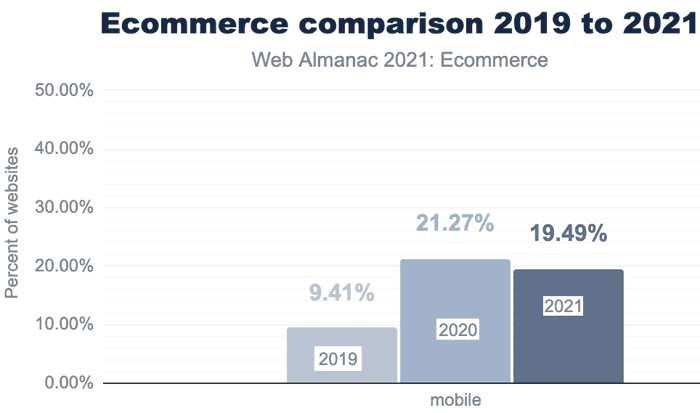HTTPArchive examined the data from 8.2 million websites. The data provided insights into which ecommerce sites are most popular and what kinds of sites use them. While the most surprising revelation is in the category of site performance, the conclusion the authors reach about which is best makes a lot of sense.
Decline And Increase in Ecommerce Sites
The following statistics are based on 8.2 million websites (both desktop and mobile versions) visited by Chrome users.
The number of ecommerce sites online increased between 2020 and 2021. But the percentage of all sites that are ecommerce actually shrunk by almost 2%, according to the data that was collected.

Ecommerce Platforms Increased
The research noted that the number of ecommerce platforms detected increased year over year, by a full 48% (215 platforms versus 145 the previous years).
Nevertheless, WordPress has the overwhelming lead over all other platforms, holding a 30% share of all mobile ecommerce sites through the WooCommerce plugin.
Shopify is in second place with a 14% share, followed by the open source PrestaShop platform with a 5% share of all ecommerce sites.
The following graph shows the percentage of ecommerce sites out of a combined ecommerce and non-ecommerce sites.

WooCommerce/WordPress ecommerce sites comprise nearly 6% of all sites, Shopify at nearly 3% and PrestaShop at just under 1%.
40% of Top 10 Ecommerce Platforms are Open Source
The research shows that 40% of the top ten ecommerce sites are open source or self-hosted.
- WooCommerce
- PrestaShop
- Magento
- Shopware.
60% of Top 10 Ecommerce Platforms are SaaS
The remaining 60% are Software as a Service (SaaS) ecommerce platforms.
- Shopify
- Wix eCommerce
- Squarespace Commerce
- BigCommerce
- Shopware
- Loja Integrada
Top Ecommerce Platforms Measured By CrUX Rank
The Chrome User Experience Report (CrUX) this year provided a popularity rank for websites.
Popularity rank means that websites are tagged as belonging to the top 1 million, to lower than the top 1 million, top 100,000 and the top 10,000 websites, as measured by popularity.
This breakdown yielded interesting analysis that revealed insights about the kinds of sites that use the different ecommerce platforms.
Website Popularity of Top 5 Ecommerce Platforms
WooCommerce
WordPress WooCommerce was the most popular platform and many of the sites were among the top million most popular sites.
PrestaShop
Shopify
There were more sites in the top million that used Shopify (as a percentage) than all other platforms.
Magento
Magento appears to be popular with enterprise level ecommerce sites, as more of the top 10,000 used Magento than the other platforms.
Wix
Wix appears to be the choice of local small business sites for ecommerce. According to the researchers only 164 Wix ecommerce sites appeared in the top 1 million sites by popularity.
Almost all of the Wix ecommerce user based were ranked less than 1 million by popularity. The statistics suggest that the dominant Wix user are small businesses.
Ecommerce Platform For Top 1 Million Sites
WooCommerce was the most popular platform for sites ranked among the top 1 million sites.
WooCommerce was followed by Shopify in second place and Magento in third.
PrestaShop held fourth place while Shopware, BigCommerce, and Salesforce Commerce Cloud held on to the fifth, sixth and seventh places.
Top 100,000 Sites
Magento is popular among the top 100,000 websites, with WooCommerce dropping to fourth place. This reinforces the impression that Magento is a popular ecommerce platform enterprise level ecommerce sites.
The research author observed:
“When we consider the top 100,000 sites by CrUX rank the picture changes quite drastically. Magento is now the most popular ecommerce platform vendor with 1.21% of mobile sites.
Shopify maintains second place (with 0.88%) while Salesforce Commerce Cloud is third (0.63%).
SAP Commerce Cloud rises up the leaderboard to sixth place to show that the enterprise platforms are more competitive in this space.”
Top 10,000 Most Popular Sites
Top Level Enterprise Ecommerce
The top ecommerce platforms dramatically changes for the very top of the enterprise level.
Magento is still among the group but it drops from first place to third place.
Top 5 Enterprise Ecommerce Platforms
- SAP Commerce
- Salesforce Commerce Cloud
- Magento
- HCL Commerce (IBM WebSphere Commerce)
- Oracle Commerce
The author of the article was not surprised at the results, noting that the top enterprise ecommerce platforms are known for servicing the higher end of the enterprise ecommerce market.
For example, Magento is owned by Adobe, which publishes a number of products that are aimed at the higher end of the enterprise market, so it’s not surprising to see that the brand targets that level.
The author wrote:
“All of these platforms are commonly considered to be well suited to larger enterprises.”
Ecommerce Speed Performance Scores
The Lighthouse page speed performance scores were shockingly low.
Google’s page speed scoring operates on a scale of 1 to 100.
A score of 100 indicates a high level of page speed and a positive user experience. A score of zero essentially represents a dumpster fire.
The average page speed score for ecommerce sites was 22.
The study author speculates that the pressure to add features leads to this level of low performance.

State of Ecommerce Platforms in 2021
No platform emerged as an overall winner. Each ecommerce platform specialized in servicing a certain level of ecommerce and pretty much stuck to that focus.
WordPress is currently the leader for a range of ecommerce sites but not clearly the platform of choice across categories.
Wix appears to be a favorite of small businesses while other platforms specialized in enterprise level platforms.
The study authors noted that Wix customers were overwhelmingly popular with small businesses.
“No Wix eCommerce sites were identified in the top 100,000. Only 164 on mobile were identified in the top 1 million. Almost the entirety of the Wix eCommerce footprint was on sites ranked lower than 1 million.”
While there is no clear winner, in the realm of page speed everyone, including the ecommerce platforms come up short.
Page speed and the associated user experience is where a platform can excel and pull away from the pack.
But whoever goes for the gold will have to balance page speed with features.





![AI Overviews: We Reverse-Engineered Them So You Don't Have To [+ What You Need To Do Next]](https://www.searchenginejournal.com/wp-content/uploads/2025/04/sidebar1x-455.png)